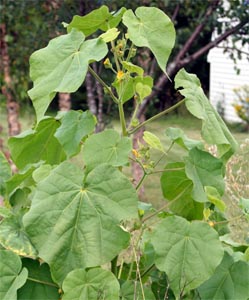
Velvetleaf, Abutilon theophrasti, is a common weed in agricultural fields, but also occurs in gardens and in disturbed sites, such as along roadsides and beside railroad tracks, throughout much of the U.S., and parts of Wisconsin. It is a particular problem in corn and soybean files in the eastern and midwestern U.S., costing hundreds of millions of dollars per year in control and damage. Velvetleaf is an extremely competitive plant, stealing nutrients and water away from crops, thereby significantly reducing yields. Velvetleaf is considered to be a noxious weed in several states, including Colorado, Iowa, Oregon and Washington.
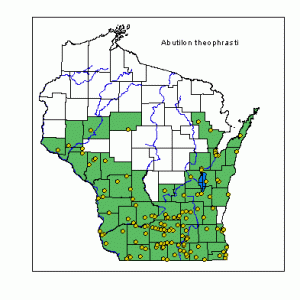
Its common name comes from the soft leaves which are covered in short hairs, creating a velvety feel. Also known as butter print and China jute, A. theophrasti comes originally from India and tropical Asia and is in the mallow family (Malvaceae). Velvetleaf is a rather tall and lanky plant with large leaves. It is easy to identify because there is really nothing else in our area that resembles it. Other introduced weedy members of the mallow family are much smaller plants, and the native Hibiscus species are perennials with darker foliage and much larger flowers.
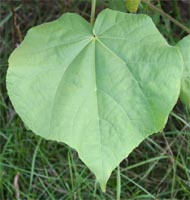
Velvetleaf is usually considered to be an annual, although it can grow as a short lived perennial in zones 8-11. It can grow up to 8 feet tall in a single season but is usually 2-4 feet tall. It has been grown in China since around 2000 B.C. for its strong, jute-like fiber in the erect stem for making cords, nets, woven bags, rugs and other coarse textiles. The Chinese also used the plant for medicinal purposes to treat fever, dysentery, stomachaches and other problems.

Velvetleaf typically occurs where the soil has been recently disturbed and the long dormant seeds are brought close to the soil surface. Seeds sprout anytime the soil is warm enough. Seedlings have one round and one heart-shaped cotyledon. The first true leaves are heart-shaped, with toothed margins.
This plant prefers full sun and fertile loam or clay-loam. The level of nitrogen, has a strong influence on the size of the plant. The plant quickly grows to produce larger and larger alternate, palmate, heart-shaped leaves that taper to a point (acuminate) with prominent veins. Both sides of the leaves and the petioles are densely hairy. The plants produce both a taproot and a fibrous root system. All upper parts off the plant have an unpleasant odor when crushed.
In midsummer orange-yellow flowers are produced on short stalks from the leaf axils on the upper part of the stem. The solitary flowers have 5 petals and are from ½ to 1” in diameter.
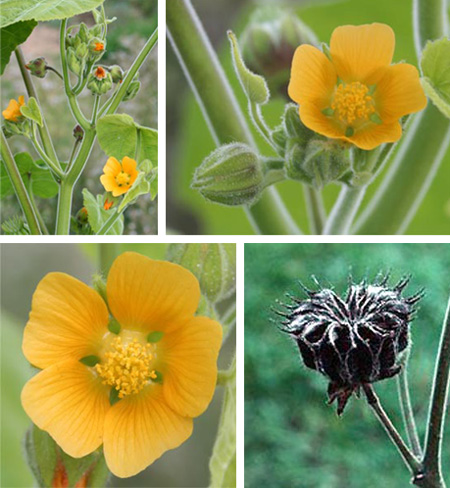
The flowers are followed by interesting fruits. The capsules are cup-shaped, with a ring of prickles around the upper edge and a series of crimps along the sides that resemble the fluted edge of a pie crust. The fruit is initially light green but rather quickly turns brown or black.
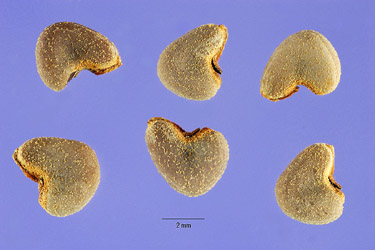
The 1” seed pods contain 5 to 15 greyish-brown, flattened seeds about 1/8” long. Each plant produces 700 to 17,000 viable seeds. The seeds can remain viable in soil for over 50 years.
The seeds are eaten by humans in China and Kashmir. In the U.S., the prairie deer mouse (Peromyscus maniculatus) and the white-footed mouse (Peromyscus leucopus), eat 70-90% of the seeds produced in Iowa corn fields, and likely they or similar rodents do the same elsewhere. Many insects also feed on the seeds, especially the native scentless plant bug (Rhopalidae) Niesthrea louisianica, whose immatures and adults feed on seeds of malvaceous plants. Inundative releases of this bug were used for biological control in New York and four midwestern states, resulting in a significant reduction in seed viability in the areas where it was established. Although they will feed on ornamentals in the mallow family, such as Rose-of-Sharon, they don’t cause noticeable damage to the plants.
– Susan Mahr, University of Wisconsin – Madison
Latest from Wisconsin Yard & Garden
Ask Your Gardening Question
If you’re unable to find the information you need, please submit your gardening question here:





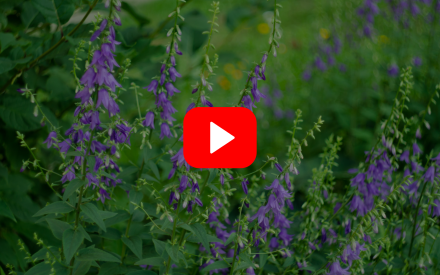 ▶ Watch: Biology and Management of Canada Thistle, Bishop's Goutweed, and Creeping Bellflower
▶ Watch: Biology and Management of Canada Thistle, Bishop's Goutweed, and Creeping Bellflower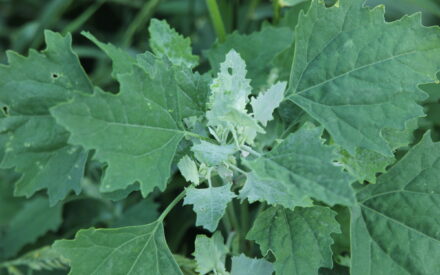 Common Weed Seedlings of the North Central States
Common Weed Seedlings of the North Central States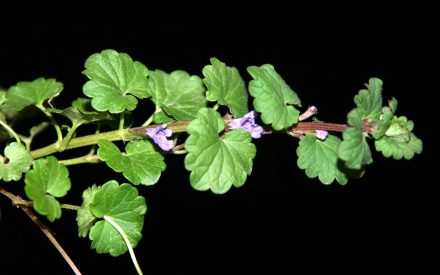 Creeping Charlie, Gleochoma hederaceae
Creeping Charlie, Gleochoma hederaceae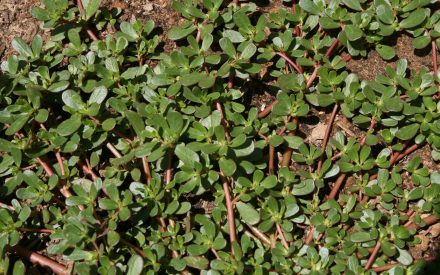 Common Purslane, Portulaca oleracea
Common Purslane, Portulaca oleracea


